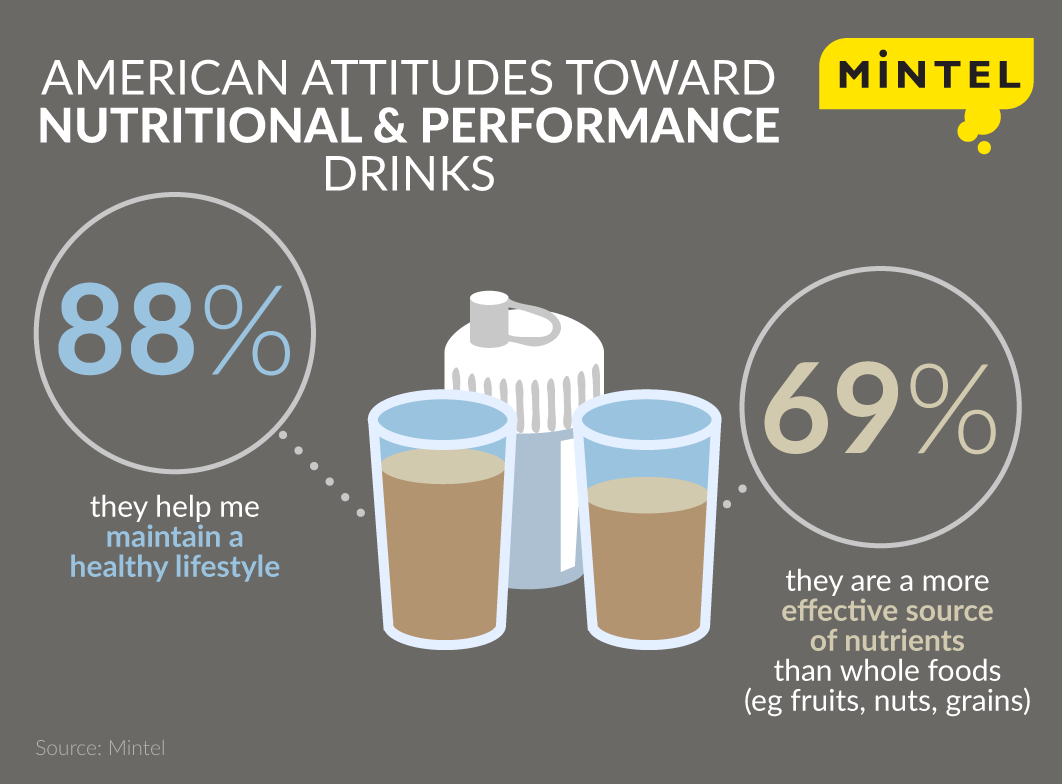Two in five US consumers are replacing their breakfast with nutritional and performance drinks
Thanks to the evolving dietary habits of on-the-go consumers and positive functional attributes, nutritional and performance drinks are becoming an increasingly popular meal option. With one third (35 percent) of Americans agreeing that they do not take care of themselves as well as they should because of their busy lifestyle, new research from Mintel reveals that 39 percent of consumers* use nutritional and performance drinks as a replacement for breakfast. What’s more, three in five (58 percent) consumers currently use nutritional and performance drinks as a meal replacement and 48 percent consume them as part of a meal, up from just 20 percent who used nutritional drinks as a meal supplement in 2012.
80% of consumers view nutritional and performance drinks as a great guilt-free snack
In addition to seven in 10 (69 percent) consumers agreeing that nutritional and performance drinks are a more effective source of nutrients, the majority of consumers agree that they are more convenient (79 percent) than whole foods (eg fruits, nuts, grains). With consumers viewing their efficacy favorably, it’s no wonder that 40 percent are consuming nutritional and performance drinks before, during or after exercising. These drinks are also carving out their share of the snacking category as 80 percent of consumers view these beverages as a great guilt-free snack.
Overall, nine in 10 (88 percent) consumers agree that nutritional and performance drinks help them maintain a healthy lifestyle.
“The functional aspect of nutritional and performance drinks sets them apart from other drink categories at a time when consumers are looking for products that contribute to a healthy lifestyle,” said Beth Bloom, Senior Food and Drink Analyst at Mintel. “Nutritional and performance drinks are the apex of convenience for the modern American lifestyle and diet, as consumers are moving away from three meals per day and are snacking more often. These beverages deliver on convenience, affordability and efficacy, a trio of positive advantages that appeal to today’s on-the-go consumers that are simply too busy to eat a sit-down breakfast at home.”
Driven by their favorable functional attributes, nutritional drinks and performance drinks are gaining a larger market share of the overall category, which also includes sports drinks and weight loss drinks. From 2010-2015, performance drinks experienced 86 percent sales growth, while nutritional drinks saw 67 percent growth. The overall market grew 38 percent, reaching $13 billion in 2015.
While sales of sports drinks grew 22 percent from 2010-2015, weight loss drinks experienced stunted growth (5 percent) caused by shifts in consumer dieting habits. What’s more, just 12 percent of consumers purchase weight loss drinks in comparison to the 32 percent of Americans who buy nutritional drinks.
“General diet trends are favoring functional attributes, and we’re seeing this play out in the success of the nutritional and performance drinks category. This is further highlighted by stalled growth of weight loss drinks, which are often promoted with claims such as low-calorie or reduced sugar. Weight-loss brands should move away from ‘less bad for you’ positioning and instead highlight the ‘better-for-you’ functional benefits of replacing meals with their products, as a large amount of weight-loss drink buyers use them as meal replacements,” continued Bloom.
Despite being viewed favorably by consumers, other drink categories pose a threat to nutritional and performance drinks’ success. According to Mintel’s Global New Products Database (GNPD), from March 2015 to February 2016, 34 percent of energy drink launches in the US featured a functional claim. Over that same span, functional positioning has also been utilized in new product launches of juice/juice drinks (24 percent), water (17 percent) and coffee/tea (16 percent).
Overall, when purchasing nutritional and performance drinks, the most important factors for US consumers are favorite flavor (41 percent), amount of protein (40 percent) and high fiber (33 percent).
“Products across beverage categories have caught on to the value of functional positioning, which challenges nutritional and performance drinks at their own game. In order to stay ahead of the competition, nutritional and performance drink brands should prioritize promoting and substantiating efficacy. Brands could also secure more natural positioning by featuring competing categories’ whole foods, such as 100 percent juice, coffee and tea, as ingredients,” concluded Bloom.
*983 US adults who purchased nutritional and performance drinks in the three months ending February 2016
Press copies of the Nutritional and Performance Drinks US 2016 report and interviews with Beth Bloom, Senior Food and Drink, are available on request from the press office.
For the latest in consumer and industry news, top trends and market perspectives, stay tuned to Mintel News featuring commentary from Mintel’s team of global category analysts.
-
 Discover your next big breakthroughGet smart fast with our exclusive market research reports, delivering the latest data, innovation, trends and strategic recommendations....View Reports
Discover your next big breakthroughGet smart fast with our exclusive market research reports, delivering the latest data, innovation, trends and strategic recommendations....View Reports -
2026 Global PredictionsOur Predictions go beyond traditional trend analysis. Download to get the predictive intelligence and strategic framework to shape the future of your industry in 2026 and beyond. ...Download now
-
Are you after more tailored solutions to help drive Consumer Demand, Market Expansion or Innovation Strategy?Ask for a customised strategic solution from Mintel Consulting today....Find out more

































